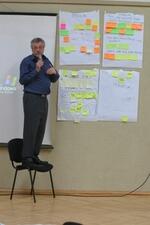 <p>The EU has published a consultationpaper on Territorial Cohesion. Ah… but what is “territorial cohesion” you may ask? That is a good question, because although the words have been around in EU-speak for some years now, it remains a difficult concept to pin down. This problem is recognised in the consultation paper itself, so maybe at the end of the process we will all be much wiser about just what it is that we are talking about! However, don’t start yawning. Keep reading. This consultation paper is relevant to all members of the IC.</p>
<p>The EU has published a consultationpaper on Territorial Cohesion. Ah… but what is “territorial cohesion” you may ask? That is a good question, because although the words have been around in EU-speak for some years now, it remains a difficult concept to pin down. This problem is recognised in the consultation paper itself, so maybe at the end of the process we will all be much wiser about just what it is that we are talking about! However, don’t start yawning. Keep reading. This consultation paper is relevant to all members of the IC.</p>
EU Green paper on territorial cohesion
The title of the consultation paper reflects the aspiration behind the idea of Territorial Cohesion. It is “Turning territorial diversity into strength”. There are wide regional variations within Europe: the opening sentences of the paper read like a movie screenplay, sweeping from the “frozen tundra in the
Thus part of the push for territorial cohesion is to tidy up unfinished business in the reform of regional policy and retrospectively to secure the 2006 Community Strategic Guidelines on Cohesion which tied “territorial cohesion” to the jobs and growth agenda. However, there was another, slightly different stimulus also. That came from the member states who adopted the “Territorial Agenda” at a meeting in
A further concern is the fact that EU directorates and their sector policies – such as the agriculture policy – pay little or no attention to the territorial dimension. The paper makes this point. In addition, DG Regio uses the consultation paper to re-iterate that it is not seeking to intrude into the members states’ areas of responsibility for land use and development planning.
The consultation invites responses (by 28 February 2009) to a number of questions. These include, amongst others:
- What is the most appropriate definition of territorial cohesion?
- Do areas with specific geographical features require specific policy measures?
- What role should the Commission play in encouraging and supporting territorial cooperation?
- Is there a need for new forms of territorial cooperation?
- Does the pursuit of territorial cohesion require the participation of new actors in policy-making, such as representatives of the social economy, local stakeholders, voluntary organisations and NGOs?
These are all questions that should be of interest to IC members and to the IC as a whole. So how about these as a set of responses?
Territorial cohesion means having a sense of solidarity between different territories and putting this into practice so that no region feels seriously disadvantaged or neglected.
Geographically disadvantaged regions do have specific needs but also special qualities that need to be conserved. The emphasis should be on helping them to realise their territorial potential rather than on open-ended subsidies.
Territorial cooperation can be a strong force for building solidarity, a shared identity and for mutual learning. The IC project showed that, as did its predecessor PIPE. These were very valuable exercises, and the Commission should ensure that similar initiatives can be supported in future. In particular it should be possible to do longer projects, with more direct continuity to previous ones. The involvement of young people is crucial to building
There should be more scope for professional secondments and placements to deepen the process of co-operation. There also needs to be better training and understanding of different cultures at every stage so as to get more out of the co-operation.
Yes, it should be easier for a variety of actors to get involved in the territorial co-operation process.

